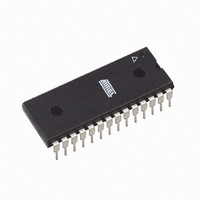ATMEGA8L-8PU Atmel, ATMEGA8L-8PU Datasheet - Page 171

ATMEGA8L-8PU
Manufacturer Part Number
ATMEGA8L-8PU
Description
IC AVR MCU 8K 8MHZ 3V 28DIP
Manufacturer
Atmel
Series
AVR® ATmegar
Datasheets
1.ATMEGA8L-8MU.pdf
(25 pages)
2.ATMEGA8L-8MU.pdf
(302 pages)
3.ATMEGA8-16PU.pdf
(305 pages)
Specifications of ATMEGA8L-8PU
Core Processor
AVR
Core Size
8-Bit
Speed
8MHz
Connectivity
I²C, SPI, UART/USART
Peripherals
Brown-out Detect/Reset, POR, PWM, WDT
Number Of I /o
23
Program Memory Size
8KB (4K x 16)
Program Memory Type
FLASH
Eeprom Size
512 x 8
Ram Size
1K x 8
Voltage - Supply (vcc/vdd)
2.7 V ~ 5.5 V
Data Converters
A/D 6x10b
Oscillator Type
Internal
Operating Temperature
-40°C ~ 85°C
Package / Case
28-DIP (0.300", 7.62mm)
Cpu Family
ATmega
Device Core
AVR
Device Core Size
8b
Frequency (max)
8MHz
Interface Type
SPI/TWI/USART
Total Internal Ram Size
1KB
# I/os (max)
23
Number Of Timers - General Purpose
3
Operating Supply Voltage (typ)
3.3/5V
Operating Supply Voltage (max)
5.5V
Operating Supply Voltage (min)
2.7V
On-chip Adc
6-chx10-bit
Instruction Set Architecture
RISC
Operating Temp Range
-40C to 85C
Operating Temperature Classification
Industrial
Mounting
Through Hole
Pin Count
28
Package Type
PDIP
Processor Series
ATMEGA8x
Core
AVR8
Data Bus Width
8 bit
Data Ram Size
1 KB
Maximum Clock Frequency
8 MHz
Number Of Programmable I/os
23
Number Of Timers
3
Operating Supply Voltage
2.7 V to 5.5 V
Maximum Operating Temperature
+ 85 C
Mounting Style
Through Hole
3rd Party Development Tools
EWAVR, EWAVR-BL
Minimum Operating Temperature
- 40 C
Controller Family/series
AVR MEGA
No. Of I/o's
23
Eeprom Memory Size
512Byte
Ram Memory Size
1KB
Cpu Speed
8MHz
Rohs Compliant
Yes
For Use With
ATSTK600-TQFP32 - STK600 SOCKET/ADAPTER 32-TQFPATSTK600-DIP40 - STK600 SOCKET/ADAPTER 40-PDIP770-1007 - ISP 4PORT ATMEL AVR MCU SPI/JTAGATAVRISP2 - PROGRAMMER AVR IN SYSTEMATSTK500 - PROGRAMMER AVR STARTER KIT
Lead Free Status / RoHS Status
Lead free / RoHS Compliant
Available stocks
Company
Part Number
Manufacturer
Quantity
Price
Company:
Part Number:
ATMEGA8L-8PU
Manufacturer:
BROADCOM
Quantity:
101
Company:
Part Number:
ATMEGA8L-8PU
Manufacturer:
ATMEL
Quantity:
33 600
Part Number:
ATMEGA8L-8PU
Manufacturer:
ATMEL/爱特梅尔
Quantity:
20 000
Company:
Part Number:
ATMEGA8L-8PU-QS096
Manufacturer:
ATMEL
Quantity:
56
Using the TWI
2486O–AVR–10/04
The TWAR should be loaded with the 7-bit Slave address (in the seven most significant
bits of TWAR) to which the TWI will respond when programmed as a Slave Transmitter
or Receiver, and not needed in the Master modes. In multimaster systems, TWAR must
be set in masters which can be addressed as Slaves by other Masters.
The LSB of TWAR is used to enable recognition of the general call address (0x00).
There is an associated address comparator that looks for the slave address (or general
call address if enabled) in the received serial address. If a match is found, an interrupt
request is generated.
• Bits 7..1 – TWA: TWI (Slave) Address Register
These seven bits constitute the slave address of the TWI unit.
• Bit 0 – TWGCE: TWI General Call Recognition Enable Bit
If set, this bit enables the recognition of a General Call given over the Two-wire Serial
Bus.
The AVR TWI is byte-oriented and interrupt based. Interrupts are issued after all bus
events, like reception of a byte or transmission of a START condition. Because the TWI
is interrupt-based, the application software is free to carry on other operations during a
TWI byte transfer. Note that the TWI Interrupt Enable (TWIE) bit in TWCR together with
the Global Interrupt Enable bit in SREG allow the application to decide whether or not
assertion of the TWINT Flag should generate an interrupt request. If the TWIE bit is
cleared, the application must poll the TWINT Flag in order to detect actions on the TWI
bus.
When the TWINT Flag is asserted, the TWI has finished an operation and awaits appli-
cation response. In this case, the TWI Status Register (TWSR) contains a value
indicating the current state of the TWI bus. The application software can then decide
how the TWI should behave in the next TWI bus cycle by manipulating the TWCR and
TWDR Registers.
Figure 77 is a simple example of how the application can interface to the TWI hardware.
In this example, a Master wishes to transmit a single data byte to a Slave. This descrip-
tion is quite abstract, a more detailed explanation follows later in this section. A simple
code example implementing the desired behavior is also presented.
Read/Write
Initial Value
TWA6
R/W
1
TWA5
R/W
1
TWA4
R/W
1
TWA3
R/W
1
TWA2
R/W
1
TWA1
R/W
1
TWA0
ATmega8(L)
R/W
1
TWGCE
R/W
0
TWAR
171

















